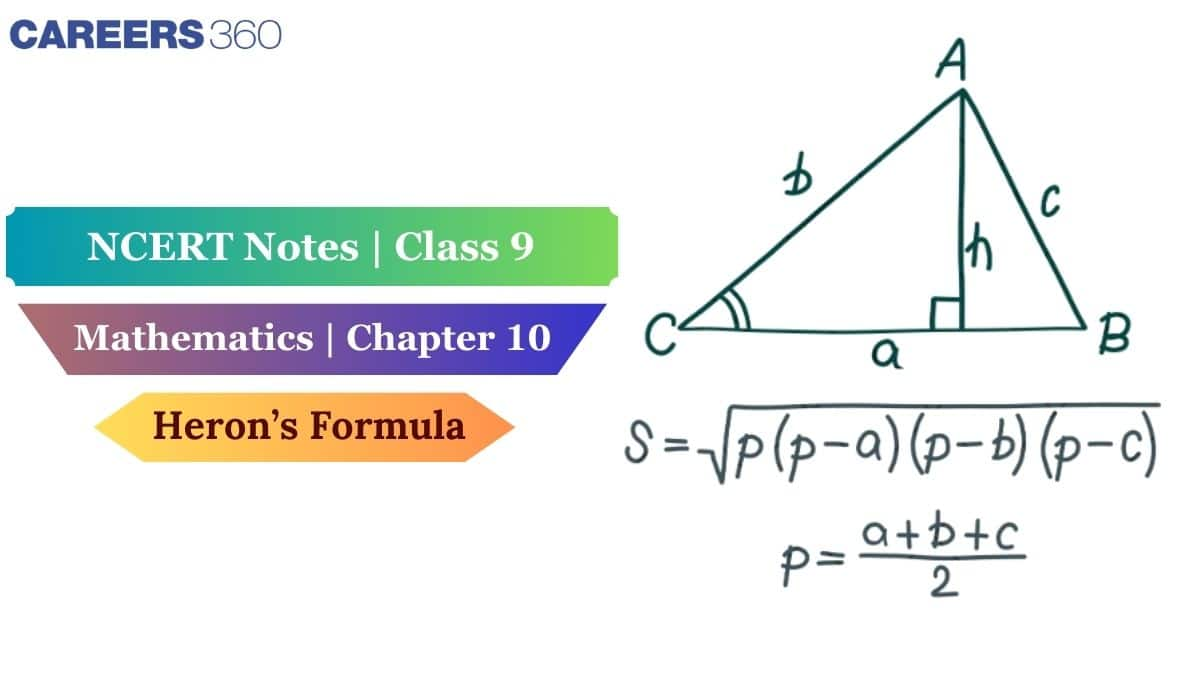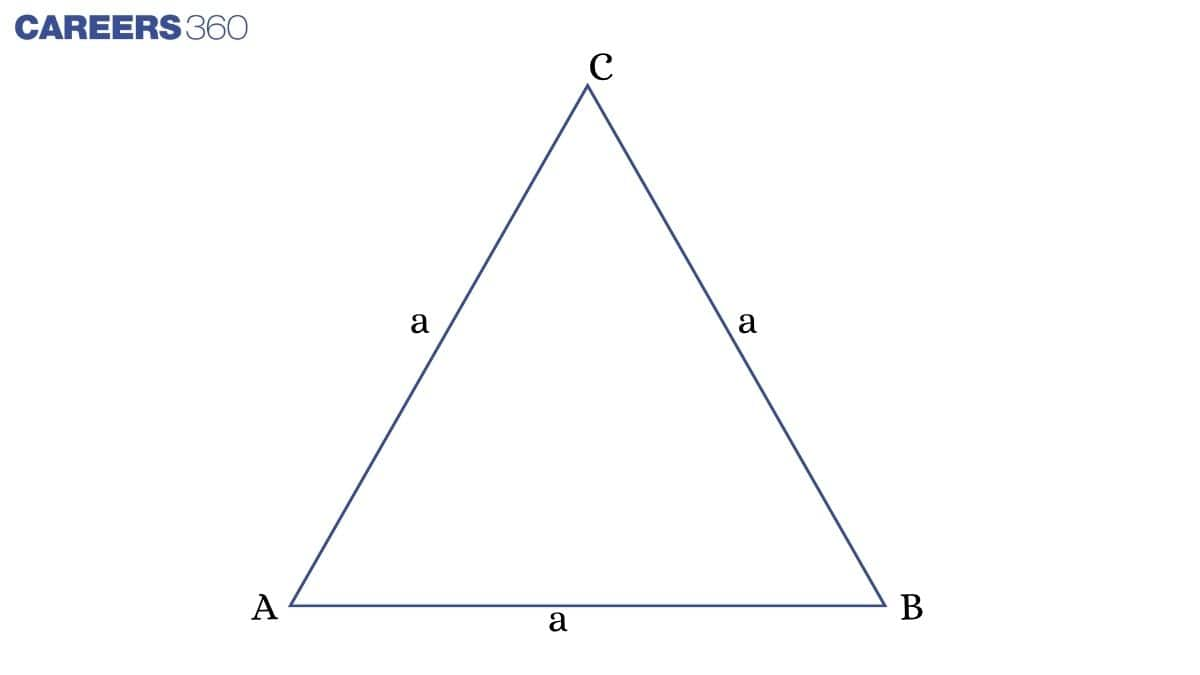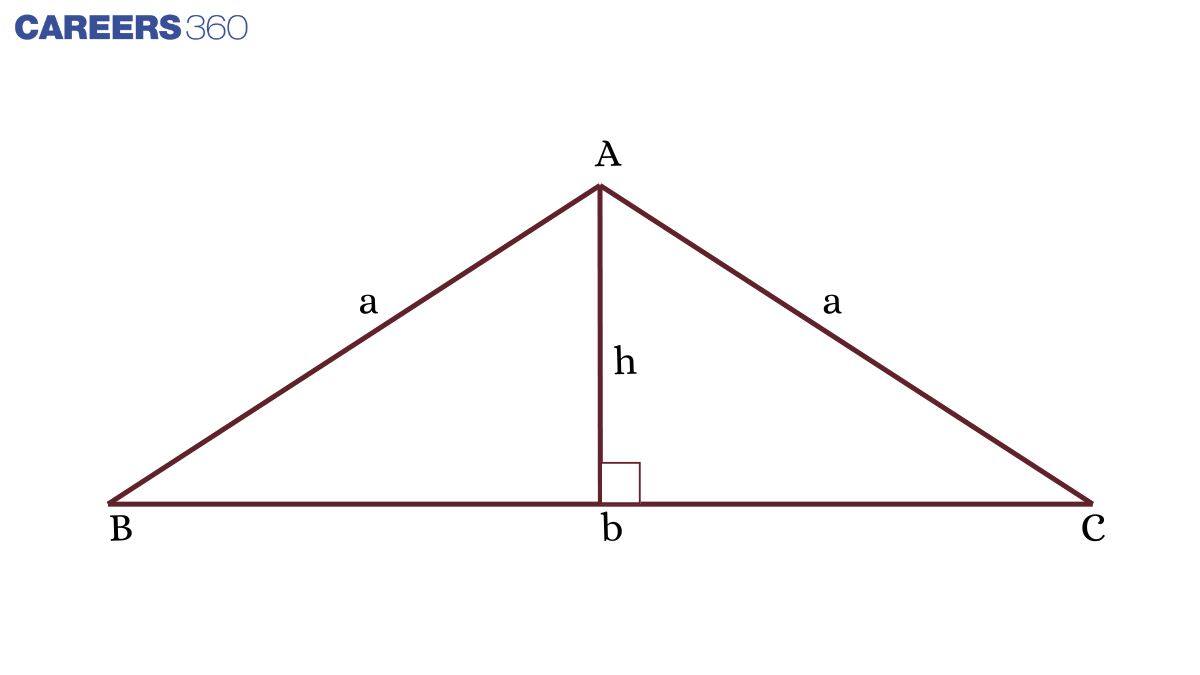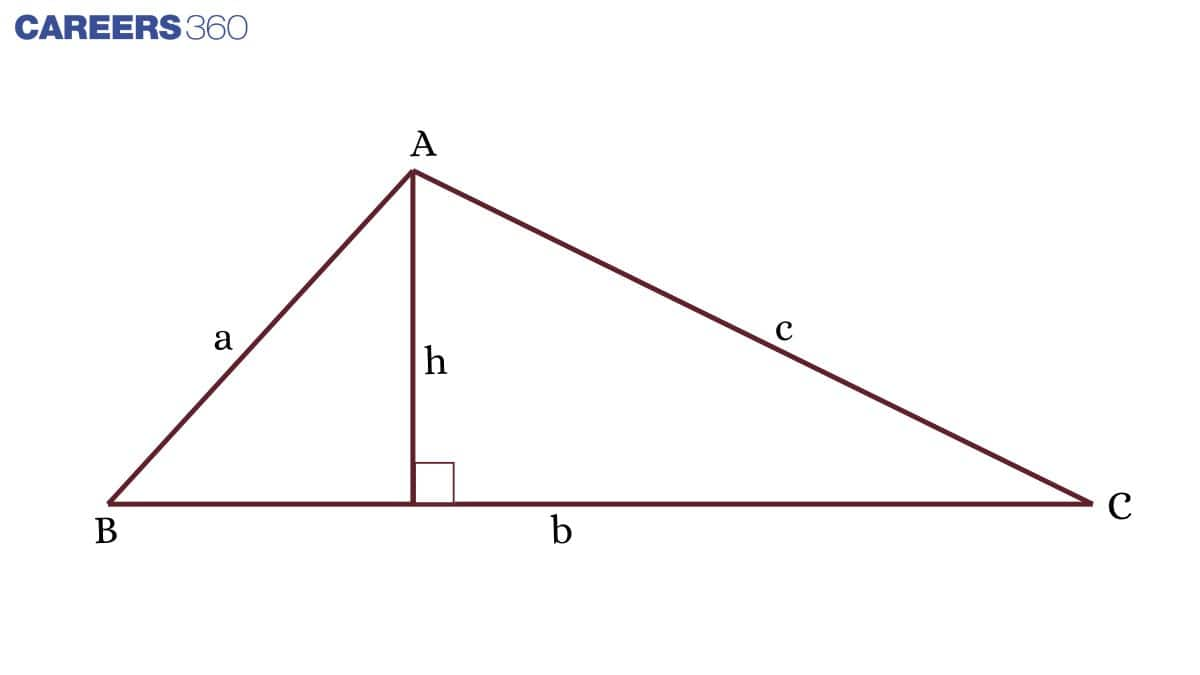NCERT Class 9 Maths Chapter 12 Notes Heron's Formula (Download PDF)
A triangle is a geometrical figure that has three sides and three corners, and three angles. It is a closed shape figure with the least number of sides. There are many types of triangles, and based on the properties, there are some formulas to calculate the area or perimeter of the triangle. The word triangle comes from the Latin word triangulus, and it means three-cornered or having three angles. Heron was a mathematician and engineer in Alexandria in Egypt, who derived the formula for calculating the area of triangles by using only the sides of the triangle. Triangles are used in many areas, like in construction, building design, sailing and navigation, art and design, pyramids, calculus, calculating distance, locating objects, etc.
This Story also Contains
- Class 9 Chapter 10 Heron's Formula Notes PDF – Download Free Study Material
- NCERT Notes Class 9 Maths Chapter 10 Heron's Formula
- Area of a Triangle by Heron's Formula
- How to Use the Heron’s Formula Class 9 Notes Effectively?
- Heron's Formula Class 9 Notes: Previous Year Question and Answer
- NCERT Class 9 Maths Notes – Chapter-Wise Links

These notes cover the basic definition of triangles, types of triangles, and formulae for calculating the area and perimeter of the triangle. Class 9 chapter includes examples for the given topics as required. Students must practice all the questions and examples to ace the topic. Subject Matter Experts designed the NCERT class 9th maths notes as per the latest syllabus. Students can download NCERT notes according to their standard and subjects.
Also, read,
Class 9 Chapter 10 Heron's Formula Notes PDF – Download Free Study Material
Careers360 brings you NCERT Class 9 Maths Chapter 10 Heron's Formula notes, carefully prepared by subject experts to simplify your studies and help in exams. A downloadable PDF is available — click the link below to access it.
NCERT Notes Class 9 Maths Chapter 10 Heron's Formula
Triangle: A geometrical closed figure that has three sides, three angles and three corners. The three corners are also referred to as the vertices of the triangle.
Types of Triangles
Triangles can be divided into two categories:
1. Based on sides
2. Based on angels
Based on Sides
1. Equilateral Triangle
2. Isosceles Triangle
3. Scalene Triangle
Equilateral Triangle
A triangle in which all sides are equal is called an equilateral triangle.

Area of equilateral triangle = $\frac{\sqrt3}{4}a^2$
Perimeter of equilateral triangle = $3a$
Where,
a is the side of the triangle.
Example: Find the area and perimeter of the equilateral triangle, in which the length of the side is 10cm.
Area of equilateral triangle = $\frac{\sqrt3}{4}10^2$
= $25\sqrt3$$cm^2$
Perimeter of equilateral triangle = $3 × 10$
= $30$
Isosceles Triangle
A triangle in which any two sides are equal is called an isosceles triangle.

Area of isosclales triangle = $\frac{1}{2}bh$
Perimeter of an isosceles triangle = $2a + b$
Example: Find the area and perimeter of the triangle whose base is 12 cm long and each equal side is 16 cm long.
Area of isosclales triangle = $\frac{1}{2}12 × 16$
Area of isosclales triangle = $96$
Perimeter of an isosceles triangle = $2 × 16 + 12$
Perimeter of an isosceles triangle = $44$
Scalene Triangle
A triangle where the length of each side is different is known as a scalene triangle.

Area of scalene triangle = $\frac{1}{2}bh$
Perimeter of an scalene triangle = $a + b + c$
Area of a Triangle by Heron's Formula
Heron was a mathematician and an engineer in Alexandria in Egypt. He defined a formula to determine the area of a triangle when all three sides are known. The Heron's formula for determining the area of a triangle is as follows:
Semiperimeter (S) = $\frac{(a + b + c)}{2}$
Where a, b, and c are the sides of the triangle.
Area of triangle = $\sqrt {s(s - a)(s - b)(s - c)}$
Example: Find the area of a triangle whose sides are 4 cm, 5 cm and 7cm, respectively.
Semiperimeter (S) = $\frac{(a + b + c)}{2}$
Semiperimeter (S) = $\frac{(4 + 5 + 7)}{2}$
Semiperimeter (S) = $8$
Area of triangle = $\sqrt {8(8 - 4)(8 - 5)(8 - 7)}$
Area of triangle = $\sqrt {96}$$cm^2$
How to Use the Heron’s Formula Class 9 Notes Effectively?
Heron’s formula becomes easy when we understand how to use the side lengths of a triangle to find its area. This chapter mainly teaches us one formula, so practising it with different triangles helps a lot. Here are some more points on how these Class 9 Maths chapter 10 notes are important.
- Read the formula and its steps carefully, then try simple examples to understand how to use it.
- Practise different types of triangles so we get comfortable with finding the semi-perimeter and applying the formula correctly.
- Keep the NCERT Class 9 Maths chapter 10 notes beside you when solving questions to check each step and avoid calculation mistakes.
- Use the NCERT Class 9 Maths chapter 10 notes to build a strong base, because this method will be helpful again in higher classes when finding areas in geometry and trigonometry.
Heron's Formula Class 9 Notes: Previous Year Question and Answer
Question 1:
The three sides of a triangle are 7 cm, 9 cm, and 8 cm. What is the area of the triangle?
Solution:
Using the formula:
$s = \frac{(a + b + c)}{2}$
$s = \frac{(7 + 9 + 8)}{2}$
$s = \frac{24}{2}$
$s = 12$ cm
Now, plug the values of a, b, c, and s into Heron's formula to find the area of the triangle:
$\sqrt{(s(s - a)(s - b)(s - c))}$
$=\sqrt{(12(12 - 7)(12 - 9)(12 - 8))}$
$=\sqrt{(12 × 5 × 3 × 4)}$
$=12\sqrt{5}$ Sq. cm
Therefore, the area of the triangle with side lengths 7 cm, 9 cm, and 8 cm is approximately $12\sqrt{5}$ Sq. cm
Hence, the correct answer is $12 \sqrt{5} \;\mathrm{Sq}. \mathrm{cm}$.
Question 2:
The sides of a triangle are 8 cm, 12 cm, and 16 cm. What is the area of the triangle?
Solution:
The sides of the triangle are 8 cm, 12 cm, and 16 cm.
Semi perimeter = $\frac{8+12+16}{2}$ = 18
Area of the triangle = $\sqrt{18×(18 - 8)×(18 - 12)×(18 -16)}$
= $\sqrt{18×10×6×2}$
= $\sqrt{2160}$
= $12\sqrt{15}\ \text{cm}^2$
Hence, the correct answer is $12\sqrt{15}~\text{cm}^2$.
Question 3:
Find the area of a triangle whose sides are 10 cm, 12 cm, and 18 cm.
Solution:
The area of a triangle by Heron's formula = $\sqrt{s(s - a)(s - b)(s - c)}$
where $a$, $b$, and $c$ are the sides of the triangle, and $s$ is the semi-perimeter of the triangle.
Now, $s = \frac{a + b + c}{2}= \frac{10 + 12 + 18}{2} = 20$
So, the area $=\sqrt{20(20 - 10)(20 - 12)(20 - 18)} = \sqrt{20 \times 10 \times 8 \times 2} = 40 \sqrt{2} \text{ cm}^2$
Hence, the correct answer is $40 \sqrt{2} \text{ cm}^2$.
NCERT Class 9 Maths Notes – Chapter-Wise Links
Access all NCERT Class 9 Maths notes from one place using the links below.
|
NCERT Notes for Class 9 Maths Chapter 4 Linear Equations in Two Variables |
|
NCERT Notes for Class 9 Maths Chapter 5 Introduction to Euclid’s Geometry |
|
NCERT Notes for Class 9 Maths Chapter 10 Heron's Formula |
|
NCERT Notes for Class 9 Maths Chapter 11 Surface Areas and Volumes |
NCERT Solutions for Class 9
Students must check the NCERT solutions for Class 9 Maths and Science given below:
NCERT Exemplar Solutions for Class 9
Students must check the NCERT exemplar solutions for Class 9 Maths and Science given below:
NCERT Books and Syllabus
To learn about the NCERT books and syllabus, read the following articles and get a direct link to download them.
Courses After 12th
Applications for Admissions are open.
As per latest syllabus. Physics formulas, equations, & laws of class 11 & 12th chapters
JEE Main Important Chemistry formulas
Get nowAs per latest syllabus. Chemistry formulas, equations, & laws of class 11 & 12th chapters
JEE Main high scoring chapters and topics
Get nowAs per latest 2024 syllabus. Study 40% syllabus and score upto 100% marks in JEE
JEE Main Important Mathematics Formulas
Get nowAs per latest syllabus. Maths formulas, equations, & theorems of class 11 & 12th chapters
